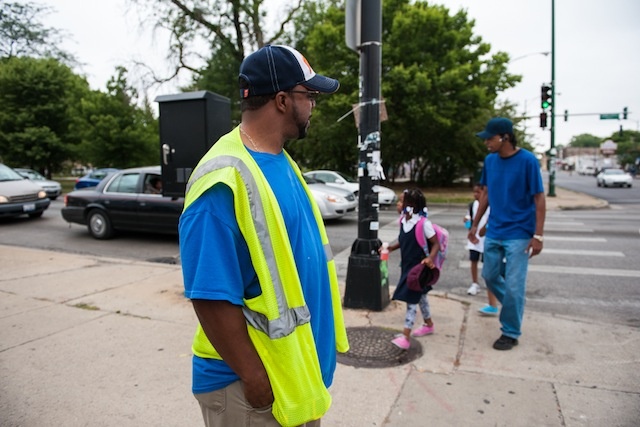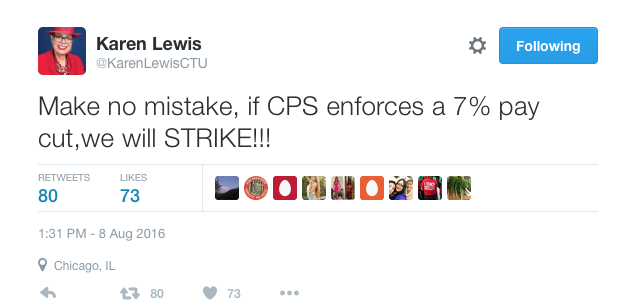It’s back to school for the largest majority of Chicago’s school children, the near 400,000 who will attend Chicago Public Schools. Never in my lifetime has the beginning of a school year been marked with so much uncertainty. One can almost not mention the dawning school year without a great big BUT showing up.
I have been talking to a lot parents in recent weeks and the BUT is all in our conversations about school these days. The uncertainty is palpable. The stress level is really, really high. And I just wonder how much more pressure this whole system can take. I believe that in the face of such uncertainty, now is an appropriate time to turn back to foundational things like faith, family and community. I think that these are big, powerful tools that can help us face big, difficult problems.
It’s back to school in Chicago, BUT …for how long? What about the teacher strike?
Chicago Teachers Union members are going back into the classroom without a contract. That makes parents and the public a little nervous. Add to that the fact that while we don’t know what is being accomplished in private negotiations (negotiations over our money, I might add) it doesn’t seem like the school district and union are anywhere close to an agreement. Chicago Public Schools CEO Forest Claypool insists that the basic framework for the deal that the school district offered is fair and reasonable (and was lauded as “a serious proposal” by CTU President Karen Lewis and later affirmed by an independent, third-party fact finder). But, the Chicago Teachers Union does not agree.
The “Big Bargaining Team” at the union rejected the proposal when it was first offered. Union leaders quickly changed their tone after the group voted and began to push for a strike should a better proposal not be offered. As the final month of the summer began to wane, the Big Bargaining Team urged members to prepare for a walkout if no deal has been reached by the end of September. Lewis was a bit more explicit with this tweet:
And the language from the Union doesn’t sound like a group that’s very hopeful for a deal. The union is not going to walk out now and shut down the first day of school. But, that decision is not the result of a great desire to reach a deal and avoid the interruption of school for hundreds of thousands of students and their families. It is rather a political “strategy” to ensure that the union is strong and prepared for the October work stoppage. This is from the CTU Contract Bulletin in August:
“[Union members’] anger is morally justified, but anger needs to be married with strategy in order to win the best possible outcome. After an entire summer of living on savings, after a summer with little contact with one another, after a summer away from students and families, our members are less secure and less united than we need to be.”
Hmmm…how long is this “back to school” deal really going to last?
CTU will take another strike vote. And there is a chance that dissenting voices of teachers who would rather not strike might be heard. But, just ask the teacher and Chess Team coach from Englewood’s Earle Elementary and he will tell you that life can be hard for dissenting voices in a powerful union.
Yes, it is back to school time in Chicago, BUT…are we really just rearranging deck chairs on the titanic? The system is crumbling financially.
Remember a few months ago the very idea of “Back to School” was in great jeopardy? The state of Illinois was careening toward the start of a second straight fiscal year without a budget. Governor Bruce Rauner and House Speaker Michael Madigan were locked in a heated stalemate over the governor’s “Turnaround Agenda” and the Democratic leader’s own spending priorities. And caught in the middle was Chicago Public Schools in dire need of state funding to make ends meet.
In mid-June, I had begun to believe that they would be content to let schools around the state not open on time. But, then who can do without “Back to School” (even if it is only a temporary arrangement)? So, on June 30th, the leaders of our state’s government brought forward a budget agreement that would indeed save “Back to School”. And appropriately, we celebrated.
But, now that “Back to School” is here, it is time to end the celebration and begin to wrestle with the fact that the June budget deal saved “Back to School”, but it saved precious little else. The agreement was, at best, a stopgap. It sent some money from the state to Chicago Public Schools, but still left the locals to add to a rapidly compounding property tax load being borne by homeowners in this city. And the deal leaves $200 million of the funding for CPS contingent upon the legislature reaching a deal on pension reform (something that is just not likely to happen). And even if it does, this budget deal only pays for the current school year.
Add to this the fact the current CPS budget is based upon the CTU taking a deal that they have made clear they have no plan to take (see above) and also add the fact that CPS just did another huge round of borrowing (to the tune of nearly a billion dollars) for capital improvement. Some watchdog groups suggest that the district is in real trouble as it relates to the debt load. A reality that is only compounded by an ever-compounding pension obligation and turmoil in communities around the city exacerbating the needs of the children CPS is charged to serve.
How many “Back to Schools” does CPS have left in the fiscal trick bag? Can we really sustain this current “Back to School” for an entire year? Nobody sneeze.
Is it “Back to School” time in Chicago, BUT…are the schools really working for Black students in the first place?
Let’s say that by some miracle we are able to avoid a teacher strike and get the school district on some semblance of solid financial footing, we’d still have a heck of a lot of work to do when it comes to serving the needs of Black students in Chicago.
Chicago Public Schools is presently on a victory lap touting improved high graduation rates. But, allow me to rain on the parade a little. When I look into the numbers I see some things that beg for a little further explanation.
The 5-year cohort graduation rate is up to 73.5 percent and 1,400 more students received diplomas this year than received one last year. But, the district has not yet disclosed how much of a contribution “Options Schools” have made to the increase. “Options Schools” are privately run centers designed to provide accelerated tracks to a high school diploma for students who are at risk of dropping out or who have dropped out already. There are 27 of these schools operating in Chicago.
CPS is pushing the narrative that “Non-selective neighborhood schools” are the driving force behind these gains. (The headline from this Chicago Sun-Time article wouldn’t suggest that traditional schools still lag 5 percentage points behind charter school performance on this measure.) But, while that narrative is compelling, we don’t know how many of those graduates actually finished at the neighborhood school. When students complete the accelerated “Options” program, they are counted as a graduate from the last CPS school they attended. A convenient policy if you are trying to reshape the image of neighborhood schools.
But, even if you take the story just the way it is currently being served up, the fact remains that Black males have the lowest graduation rate of any group in CPS. Nearly over 40% of Black males won’t graduate from Chicago Public Schools…even if policy has made it easier.
Maybe the dismal PARCC scores reported in August provide some clarity?
Yes, it is unfortunate, but true. “Back to School” in Chicago “got a big ole BUT”. There is unprecedented uncertainty surrounding our public system. Perhaps, though, the biggest BUT of all is this one:
We are facing seemingly insurmountable problems, BUT we can we fix them if we turn back to our roots: faith, family and community. School systems are not the only institutions that can innovate. The Black family has been doing it for a very long time. We built the Underground Railroad, mounted a movement for the abolition of slavery, and saved this nation with a grassroots movement for love and human dignity called the Civil Rights movement. These ideas were not born in anyone’s university. They were hatched around dinner tables and in church basements. They did not emanate from the minds of highly paid policy professionals, but rather from the heart of a people deeply committed to betterment of the world in which their children and grandchildren would live.
This is the force that is needed to save our children and reshape our education system for this new world in which we live. BUT, do we have the courage to tap into it?
Latest posts by Chris Butler (see all)
- Fellow Parents of Color, We Really Can Do This Homeschooling Thing - April 13, 2020
- Elected School Board Is A Distraction, Not A Solution - March 20, 2017
- 3 Stupid, Racist Responses to Chance’s $1 Million Dollar Action - March 7, 2017

